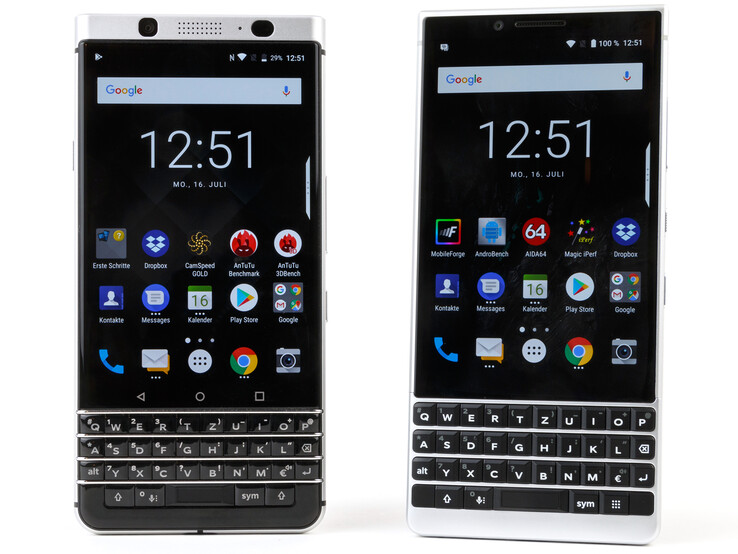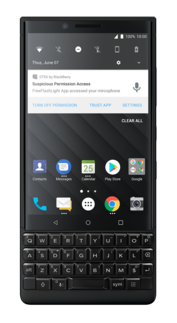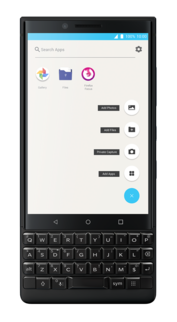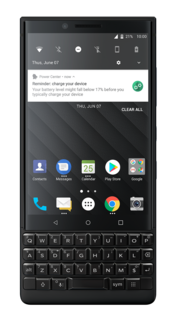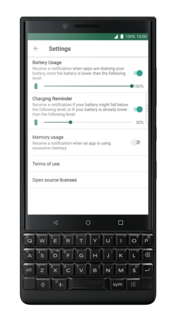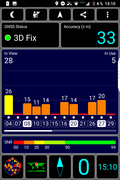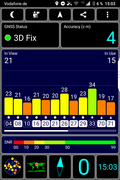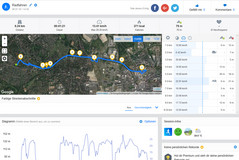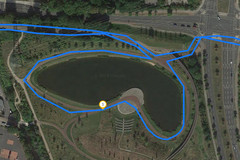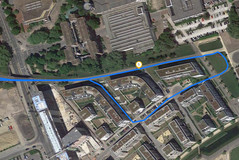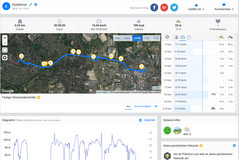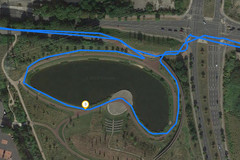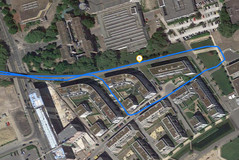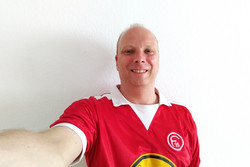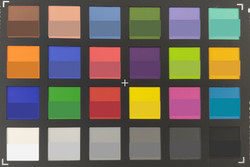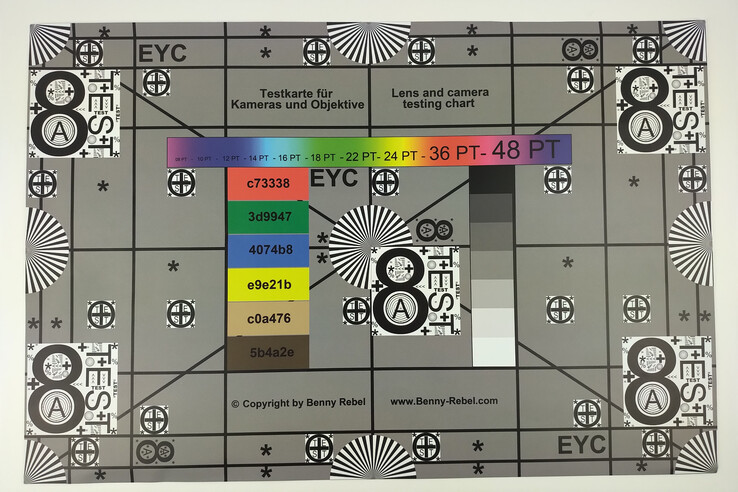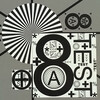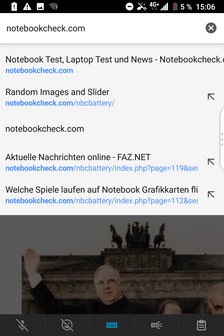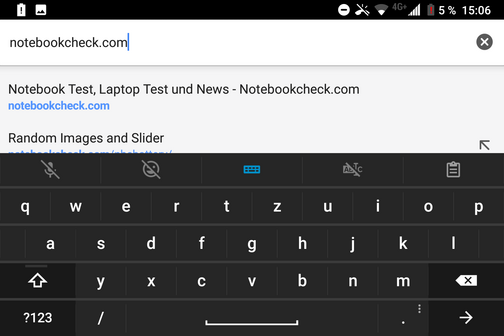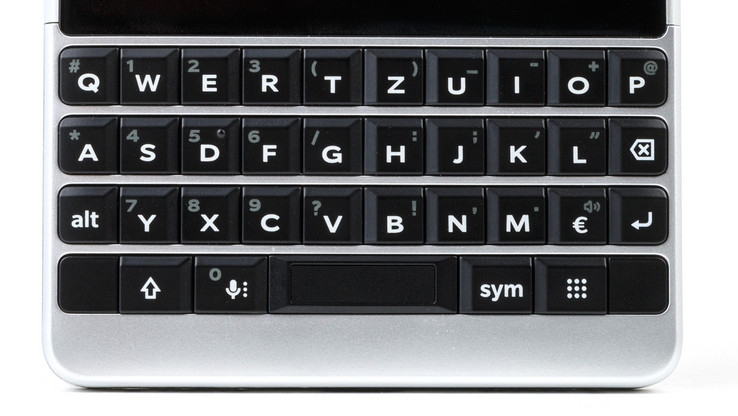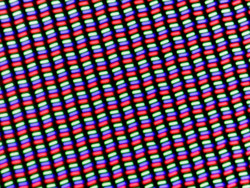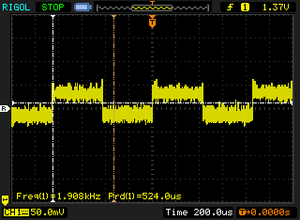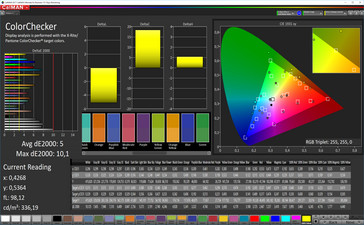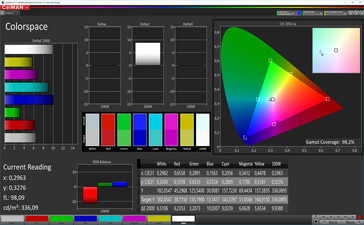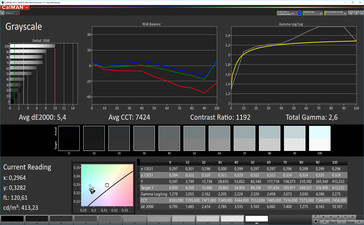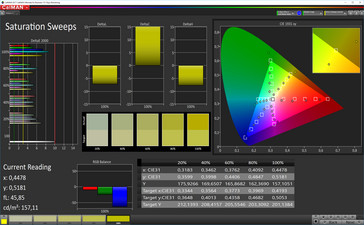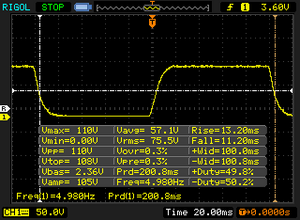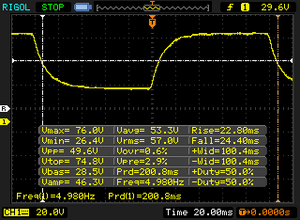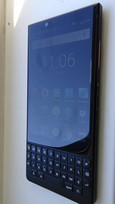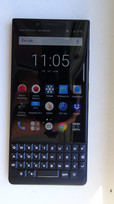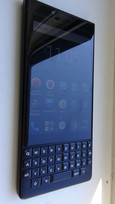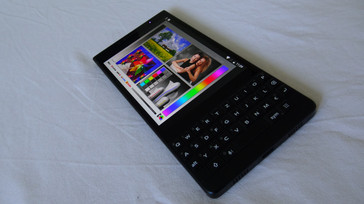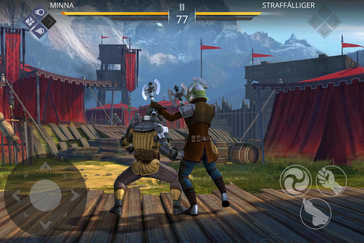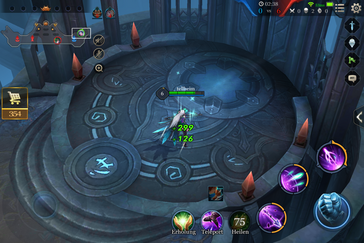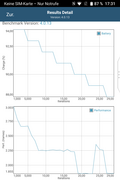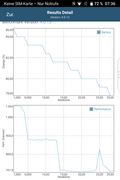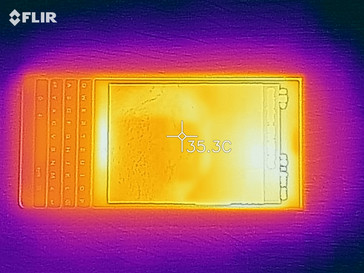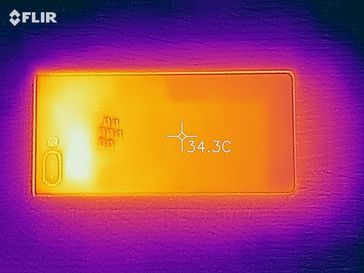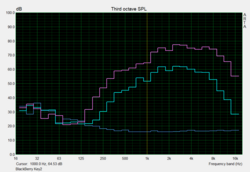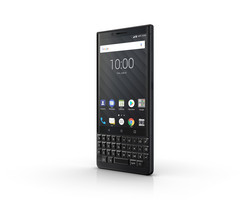BlackBerry KEY2 Smartphone Review
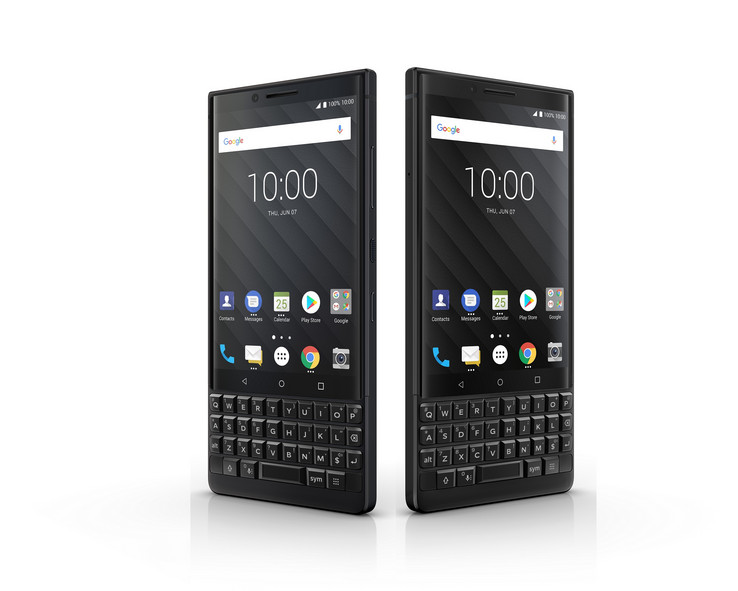
BlackBerry is now run under licence by TCL, a Chinese manufacturer. This change from the company’s historical ownership is part of the reason why the BlackBerry KEY2 runs practically stock Android Oreo 8.1 except for some additional business and security features.
They KEY2 measures only 151 x 71 x 8.5 mm (~6 x 2.8 x 0.33 in) despite its physical keyboard with its integrated fingerprint reader and thirty-five backlit keys. This compactness comes at the cost of the display size, resulting in the KEY2 having a 4.5-inch display. This is a 1,620x1,080 panel that has a 433 PPI pixel density.
The case has a non-slip back, which contains a 3,500 mAh battery that is not user replaceable. The KEY2 is equipped with 64 GB eMMC flash storage that can be expanded with up to a 256 GB microSD card. One other feature is the comfort button on the right-hand side of the device. This can be freely configured for any use, perhaps as a camera button, for example.
The KEY2 is equipped with a Qualcomm Snapdragon 660 SoC that integrates a Qualcomm Kyro 260 processor. This octa-core CPU has four cores that are clocked at 2.2 GHz and four that are clocked at 1.8 GHz. The CPU is complemented by a Qualcomm Adreno 512 GPU and 6 GB of RAM.
The KEY2 has dual 12 MP rear-facing cameras that can record videos in up to 4K at 30 FPS. The front-facing camera is an 8 MP sensor, which can record videos in up to Full HD at 30 FPS and uses the LCD as a flash.
The KEY2 is available in either black or silver and has a €649 (~$758) RRP. Incidentally, this is the online price at launch too. This pricing puts the KEY2 in competition with the Samsung Galaxy S9. However, the Galaxy S9 is equipped with 64 GB of much faster UFS 2.1 flash storage and a considerably more powerful SoC.
You could also spend less on devices that offer comparable performance to the KEY2. The Nokia 7 Plus and the Motorola Moto G6 Plus, for example, are equipped with the same SoC as the KEY2, but they cost around €370 (~$432) and €290 (~$339) respectively. Likewise, the BlackBerry KEYone also has 64 GB of storage but costs around €430 (~$502).
Case
The KEY2 stands out from the mass of other smartphones with its carbon-look rear case. This relatively soft surface not only feels grippier in the hand than other devices, but also it means that the KEY2 is less likely to slip off smooth surfaces such as tables. The frame of the device is made of an aluminium alloy, which also feels solid.
The user-configurable comfort button, volume rocker and power button are on the right-hand side of the device with the combined microSD card and nano-SIM slot being on the opposite side. The KEY2 also has a fingerprint scanner that is integrated within the spacebar, which is the largest of the physical keyboard’s keys.
The KEY2’s relatively compact dimensions make it easy to use one-handed.
Connectivity
The KEY2 features a Snapdragon 660 SoC, an upper mid-range ARMv8 based SoC that Qualcomm introduced in mid-2017. According to Qualcomm, the Snapdragon 660 has around 30% faster cores than its predecessor, the Snapdragon 625. The Snapdragon 660 also supports Bluetooth 5, a faster LTE modem, USB 3.1, and Quick Charge 4.0.
The Snapdragon 660 integrates a 64-bit capable Qualcomm Kyro 260 CPU, which has four performance cores that operate at up to 2.2 GHz and four power-saving cores that operate at up to 1.8 GHz.
Likewise, the Snapdragon 660 includes a Qualcomm Adreno 512 GPU, which supports LPDDR3 VRAM at 933 MHz. The Adreno 512 supports Vulkan, OpenGL ES 3.1 and other modern APIs.
The Snapdragon 660 also includes a Qualcomm Snapdragon X12 LTE modem that supports LTE Cat. 13 uplink and Cat. 12 downlink. The X12 modem supports up to 600 MBit/s peak download and 150 MBit/s peak upload LTE speeds.
The KEY2 is equipped with 64 GB eMMC flash storage. While the volume is typical for devices at this price, the storage type is not. The Galaxy S9, for example, is equipped with a much faster UFS 2.1 flash memory. The speed differences between eMMC and UFS 2.1 will be most noticeable in terms of system performance. The KEY2 also supports up to 256 GB microSD cards.
The KEY2 has a USB 3.0 Type-C port that is located on the underside of the device. The Type-C port supports USB Power Delivery (PD) 2.0, USB On-The-Go (OTG) and data transfer. There is also an LED notification light above the display.
Software
The KEY2 ships with a practically stock version of Android Oreo 8.1 save for the few additional business and security features that BlackBerry has included.
BlackBerry has installed the BlackBerry Hub, which acts as a central messaging platform that incorporates other messaging apps. There is also DTEK, which allows you to monitor your device’s security status.
One standout additional feature is Privacy Shade. When enabled, only a small section of the display is visible while the rest is blacked out. This can be moved or resized with the aim of keeping prying eyes at bay from sensitive information.
BlackBerry also includes two other apps, Locker and Power Center. Locker encrypts confidential documents, while Power Center notifies you about your battery level so that you can easily monitor your battery usage throughout the day.
Communication & GPS
The KEY2 supports IEEE 802.11 a/b/g/n/ac WiFi standards and so supports both 2.4 and 5 GHz Wi-Fi networks. Our test device scored poorly in iperf3 Client (receive) with 137 MBit/s, which is 29% below average. Conversely, our test device finished second to only the Galaxy S9 in iperf3 Client (transmit) with a speed of 319 MBit/s.
Our test device achieved a relatively low -32 dBm signal attenuation when next to our 02 HomeBox 2 router.
The KEY2 supports LTE, GSM and UMTS. Additionally, the device supports Bluetooth 5.0 and has an NFC chip, the latter of which can be used with apps such as Google Pay.
| Networking | |
| iperf3 transmit AX12 | |
| Samsung Galaxy S9 | |
| BlackBerry Key2 | |
| Motorola Moto G6 Plus | |
| Nokia 7 Plus | |
| BlackBerry KeyOne | |
| iperf3 receive AX12 | |
| Samsung Galaxy S9 | |
| BlackBerry KeyOne | |
| Motorola Moto G6 Plus | |
| Nokia 7 Plus | |
| BlackBerry Key2 | |
Our test device is GPS accurate up to four meters (~13 ft) outdoors, which is impressive. However, we would expect better than its 33-meter (~108 ft) indoor GPS accuracy for a device at this price.
We then tested the KEY2’s GPS accuracy by taking it on a bike ride and comparing its results against a Garmin Edge 500, a professional navigation device. The KEY2 recorded a ten-meter (~33 ft) greater total distance covered than the Garmin, which is decent. Our test device struggled to accurately plot us through corners though, demonstrating the KEY2’s limitations as a serious navigational device.
Telephone Features & Call Quality
The KEY2 uses the Google Phone and Contact apps to handle telephony by default. You could use the BlackBerry Hub as an alternative though as it manages phone calls, emails, texts, and other instant messages apps such as Skype, WhatsApp or Line. You could, of course, install other such apps from the Google Play Store.
Our test device has good call quality regardless of whether we tested it indoors or outdoors. Our call partner was easy to understand even in areas with poor signal strength. Making calls over speakerphone also works well as the speakers are loud enough to drown out most background noise.
According to BlackBerry, the KEY2 supports both VoLTE and VoWiFi. We were unable to test these with our carrier during our tests.
Cameras
It is a nice surprise to see that BlackBerry has equipped the KEY2 with dual 12 MP rear-facing cameras when camera quality is likely to play a minor role for most business customers. The main sensor has a f/1.8 aperture, which is complemented by the secondary 12 MP sensor, which has a much smaller f/2.6 aperture. Our test device struggles with low-light shots though, despite having a f/1.8 aperture sensor. Low-light performance is so poor that we needed to always have the flash on just to get a reasonably good photo. Blurring at the edges of pictures is limited though, which is one positive.
The KEY2 has an 8 MP front-facing camera, which has a fixed focus and uses the display as a flash in lieu of an LED flash. The camera produces ok photos that are reasonably sharp, even at the picture’s edge, but other smartphones at this price take considerably better photos. The front-facing camera is particularly let down by its LCD display flash, which is noticeably weak compared to LED alternatives in other smartphones.
We then subjected the KEY2 to camera tests under controlled lighting conditions. During these tests, we photograph a test chart that simulates difficult details for cameras to accurately capture such as fine lines or text against a colored background.
Our test device performed admirably well for a business device, in our opinion. Text on red or purple backgrounds is somewhat out of focus, and the edges of lines are slightly frayed. Overall, the picture is appropriately exposed, but the colors are somewhat muddy.
Accessories & Warranty
The KEY2 comes with a charger, a USB Type-A to Type-C cable, some headphones for which BlackBerry includes a few spares and a Quick Start Guide.
BlackBerry provides the KEY2 with a twenty-four month manufacturer’s warranty. Please see our Guarantees, Return policies and Warranties FAQ for country-specific information.
Keyboard
As with many other modern Android smartphones, the KEY2 has three virtual buttons at the bottom of the display. These on-screen buttons are arranged from left to right by Home, Back and Recents.
The KEY2’s standout feature is its physical keyboard though. The keys have a pleasant pressure point when typing and are backlit. The backlighting is sufficiently bright when using the KEY2 in dark areas or at night. It will take some time to adjust to typing accurately and quickly, but this will come naturally once you start typing.
BlackBerry has done a good job of integrating the fingerprint scanner within the spacebar. The fingerprint scanner reliably recognises our fingers despite its relatively small footprint. There is also Flick Typing, which works like the swiping feature on many virtual keyboards. Language switching is relatively easy too.
Unfortunately, the keyboard has some drawbacks. Firstly, shortcuts such as copy and paste are often faster when using a virtual keyboard rather than the physical one. Our main gripe though is with the key size. We would have preferred them to be slightly larger as it is particularly cumbersome to switch between letters and numbers.
The display is also easy to type on. The display is bright and responsive, so much so that it is easier to input numbers with the virtual keyboard than it is on the physical keyboard.
Display
The KEY2 has a 4.5-inch IPS display with a 1,620x1,080 native resolution and a pixel density of 433 PPI. Other devices at this price have larger, higher resolution displays, but none has a physical keyboard like the KEY2.
We would recommend adjusting brightness manually as the ambient light sensor typically dims the display too heavily, particularly when playing games.
| |||||||||||||||||||||||||
Brightness Distribution: 93 %
Center on Battery: 569 cd/m²
Contrast: 1626:1 (Black: 0.35 cd/m²)
ΔE ColorChecker Calman: 5 | ∀{0.5-29.43 Ø4.78}
ΔE Greyscale Calman: 5.4 | ∀{0.09-98 Ø5}
98.2% sRGB (Calman 2D)
Gamma: 2.6
CCT: 7424 K
| BlackBerry Key2 IPS, 1620x1080, 4.5" | Samsung Galaxy S9 Super AMOLED, 2960x1440, 5.8" | Nokia 7 Plus IPS, 2160x1080, 6" | Motorola Moto G6 Plus IPS, 2160x1080, 5.9" | BlackBerry KeyOne IPS, 1620x1080, 4.5" | |
|---|---|---|---|---|---|
| Screen | 32% | 11% | 13% | 4% | |
| Brightness middle (cd/m²) | 569 | 529 -7% | 458 -20% | 761 34% | 641 13% |
| Brightness (cd/m²) | 548 | 527 -4% | 463 -16% | 723 32% | 622 14% |
| Brightness Distribution (%) | 93 | 96 3% | 92 -1% | 90 -3% | 89 -4% |
| Black Level * (cd/m²) | 0.35 | 0.22 37% | 0.69 -97% | 0.34 3% | |
| Contrast (:1) | 1626 | 2082 28% | 1103 -32% | 1885 16% | |
| Colorchecker dE 2000 * | 5 | 1.4 72% | 4 20% | 2.4 52% | 4.7 6% |
| Colorchecker dE 2000 max. * | 10.1 | 4 60% | 7.4 27% | 5.2 49% | 10.6 -5% |
| Greyscale dE 2000 * | 5.4 | 1.6 70% | 4.7 13% | 1.8 67% | 5.9 -9% |
| Gamma | 2.6 85% | 2.16 102% | 2.19 100% | 2.21 100% | 2.22 99% |
| CCT | 7424 88% | 6358 102% | 7425 88% | 6312 103% | 7785 83% |
* ... smaller is better
Screen Flickering / PWM (Pulse-Width Modulation)
| Screen flickering / PWM detected | 1908 Hz | ||
The display backlight flickers at 1908 Hz (worst case, e.g., utilizing PWM) . The frequency of 1908 Hz is quite high, so most users sensitive to PWM should not notice any flickering. In comparison: 53 % of all tested devices do not use PWM to dim the display. If PWM was detected, an average of 8111 (minimum: 5 - maximum: 343500) Hz was measured. | |||
Our test device has a relatively bright display with the ambient light sensor activated. X-Rite i1Pro2 rates the average maximum brightness at 548.4 cd/m² with the ambient light sensor on and 420 cd/m² with the KEY2 set to manual brightness.
The more realistic Average Picture Level (APL50) test, which uniformly distributes light and dark areas results in a maximum luminosity of 569 cd/m² at the center of the display, with APL50 measuring the darkest area at 532 cd/m². This results in a 93% uniformly bright display, which is on par with the competition.
Our test device has a 0.39 cd/m² black value as measured by the APL50 test. This and the relatively high maximum brightness combine to yield an impressive 1,626:1 contrast ratio. This means that the KEY2 has a more contrast-rich display than the Moto G6 Plus, but it falls some way behind the Nokia 7 Plus and KEYone in this regard.
The IPS panel’s colors are punchy enough for daily use, but our test device has relatively poor sRGB color space coverage. The DeltaE color and grayscale deviations from sRGB could be better too, as could the display’s color temperature.
Display Response Times
| ↔ Response Time Black to White | ||
|---|---|---|
| 24.4 ms ... rise ↗ and fall ↘ combined | ↗ 13.2 ms rise | |
| ↘ 11.2 ms fall | ||
| The screen shows good response rates in our tests, but may be too slow for competitive gamers. In comparison, all tested devices range from 0.1 (minimum) to 240 (maximum) ms. » 56 % of all devices are better. This means that the measured response time is worse than the average of all tested devices (20.2 ms). | ||
| ↔ Response Time 50% Grey to 80% Grey | ||
| 47.2 ms ... rise ↗ and fall ↘ combined | ↗ 22.8 ms rise | |
| ↘ 24.4 ms fall | ||
| The screen shows slow response rates in our tests and will be unsatisfactory for gamers. In comparison, all tested devices range from 0.165 (minimum) to 636 (maximum) ms. » 81 % of all devices are better. This means that the measured response time is worse than the average of all tested devices (31.6 ms). | ||
The KEY2 has strong viewing angles thanks to its IPS display. There are no color distortions at acute viewing angles, but there is some loss of brightness.
Our test device remains sufficiently legible outdoors thanks to its relatively bright display and strong colors.
Performance
The KEY2 is equipped with a Snapdragon 660 SoC, which we have seen in numerous other devices at this price. The SoC integrates an octa-core Qualcomm Kyro 260 CPU, of which four cores can run at up to 2.2 GHz and the other four at up to 1.8 GHz. This is complemented by 6 GB of RAM, which ensures that the KEY2 runs smoothly even after opening multiple apps.
The KEY2 is on par in CPU benchmarks with the other Snapdragon 660 powered devices that we have tested and beats many of our comparison devices. On the other hand, the KEY2 cannot compete with the Galaxy S9, which is equipped with a much faster SoC. This is to be expected though as the Galaxy S9 costs around €200 (~$234) more than the KEY2.
| AnTuTu v6 - Total Score (sort by value) | |
| BlackBerry Key2 | |
| Samsung Galaxy S9 | |
| Nokia 7 Plus | |
| Motorola Moto G6 Plus | |
| BlackBerry KeyOne | |
| Average Qualcomm Snapdragon 660 (105973 - 120479, n=11) | |
| AnTuTu v7 - Total Score (sort by value) | |
| BlackBerry Key2 | |
| Samsung Galaxy S9 | |
| Nokia 7 Plus | |
| Motorola Moto G6 Plus | |
| BlackBerry KeyOne | |
| Average Qualcomm Snapdragon 660 (116346 - 143551, n=10) | |
| PCMark for Android | |
| Work performance score (sort by value) | |
| BlackBerry Key2 | |
| Samsung Galaxy S9 | |
| Nokia 7 Plus | |
| Motorola Moto G6 Plus | |
| BlackBerry KeyOne | |
| Average Qualcomm Snapdragon 660 (6274 - 7026, n=11) | |
| Work 2.0 performance score (sort by value) | |
| BlackBerry Key2 | |
| Samsung Galaxy S9 | |
| Nokia 7 Plus | |
| Motorola Moto G6 Plus | |
| BlackBerry KeyOne | |
| Average Qualcomm Snapdragon 660 (5789 - 6426, n=13) | |
| Lightmark - 1920x1080 1080p (sort by value) | |
| Samsung Galaxy S9 | |
| Nokia 7 Plus | |
| Average Qualcomm Snapdragon 660 (n=1) | |
| Basemark ES 3.1 / Metal - offscreen Overall Score (sort by value) | |
| Samsung Galaxy S9 | |
| Nokia 7 Plus | |
| Average Qualcomm Snapdragon 660 (349 - 353, n=2) | |
| Average of class Smartphone (205 - 7731, n=36, last 2 years) | |
Our test device’s browser benchmark performance is adequate for a device at this price. Websites load reasonably quickly and scrolling on the default Google Chrome 67 browser always feels smooth.
| JetStream 1.1 - Total Score | |
| Samsung Galaxy S9 (Samsung Browser 7.0) | |
| Nokia 7 Plus (Chrome 60) | |
| BlackBerry Key2 (Chrome 67) | |
| Average Qualcomm Snapdragon 660 (45.3 - 55.5, n=12) | |
| Motorola Moto G6 Plus (Chrome 66) | |
| BlackBerry KeyOne | |
| Octane V2 - Total Score | |
| Average of class Smartphone (2228 - 121337, n=201, last 2 years) | |
| Samsung Galaxy S9 (Samsung Browser 7.0) | |
| Nokia 7 Plus (Chrome 60) | |
| BlackBerry Key2 (Chrome 67) | |
| Average Qualcomm Snapdragon 660 (8463 - 10945, n=14) | |
| Motorola Moto G6 Plus (Chrome 66) | |
| BlackBerry KeyOne (Chrome 59) | |
| Mozilla Kraken 1.1 - Total | |
| Motorola Moto G6 Plus (Chrome 66) | |
| BlackBerry KeyOne (Chrome 59) | |
| Average Qualcomm Snapdragon 660 (3796 - 4769, n=13) | |
| Nokia 7 Plus (Chrome 60) | |
| BlackBerry Key2 (Chrome 67) | |
| Samsung Galaxy S9 (Samsung Browser 7.0) | |
| Average of class Smartphone (257 - 28190, n=156, last 2 years) | |
| WebXPRT 2015 - Overall | |
| Average Qualcomm Snapdragon 660 (159 - 182, n=8) | |
| Nokia 7 Plus (Chrome 60) | |
| Samsung Galaxy S9 (Samsung Browser 7.0) | |
| Motorola Moto G6 Plus (Chrome 66) | |
| BlackBerry KeyOne (Chrome 59) | |
* ... smaller is better
The KEY2 is equipped with 64 GB of eMMC flash storage. This storage technology is still used in many devices that cost between €600-€700 (~$700-~$820), but devices such as the OnePlus 6 are now equipped with faster UFS 2.1 flash storage. The Galaxy S9 is equipped with UFS 2.1 flash storage and has significantly faster random read and sequential read speeds because of this difference in storage technology.
The KEY2 also supports up to 256 GB microSD/microSDHC/microSDXC cards. Our test device achieves decent speeds in AndroBench 3-5 with our Toshiba Exceria Pro M501 reference microSD card. The 82.52 MB/s sequential read and 61.68 MB/s sequential write speeds are on par with the Galaxy S9 and are faster than the KEYone.
| BlackBerry Key2 | Samsung Galaxy S9 | Nokia 7 Plus | Motorola Moto G6 Plus | BlackBerry KeyOne | Average 64 GB eMMC Flash | Average of class Smartphone | |
|---|---|---|---|---|---|---|---|
| AndroBench 3-5 | 61% | 3% | 47% | -25% | 13% | 941% | |
| Sequential Read 256KB (MB/s) | 273.1 | 815 198% | 283.1 4% | 286.6 5% | 267.1 -2% | 277 ? 1% | 2223 ? 714% |
| Sequential Write 256KB (MB/s) | 208.4 | 206.9 -1% | 211.6 2% | 216.1 4% | 77 -63% | 178.4 ? -14% | 1838 ? 782% |
| Random Read 4KB (MB/s) | 56.8 | 131 131% | 54.7 -4% | 58.4 3% | 36.8 -35% | 60.7 ? 7% | 295 ? 419% |
| Random Write 4KB (MB/s) | 17.18 | 23.07 34% | 19.62 14% | 62.8 266% | 12.5 -27% | 33.8 ? 97% | 335 ? 1850% |
| Sequential Read 256KB SDCard (MB/s) | 82.5 ? | 79.2 ? -4% | 82.2 0% | 83.7 ? 1% | 77.9 ? -6% | 77.4 ? -6% | |
| Sequential Write 256KB SDCard (MB/s) | 61.7 ? | 67.2 ? 9% | 62.3 1% | 62.1 ? 1% | 53.2 ? -14% | 58.3 ? -6% |
Games
A Qualcomm Adreno 512 GPU handles the graphics. The GPU is powerful enough to play most games in high details and at high refresh rates. We measured FPS with GameBench, during which “Arena of Valor” ran at the highest graphics settings without a problem. We would recommend playing more complex games such as “Shadow Fight 3” at medium graphics settings for a smooth experience though. Graphically intensive games such as “PUBG Mobile” are also playable, but we had to further reduce the graphics settings for an enjoyable experience.
The KEY2 is not designed with gaming in mind though, and its ergonomics reflect that. Games are difficult to play in landscape mode as you must hold the device awkwardly with the keyboard jutting out to one side. Moreover, the speaker is easily covered when playing games because of the odd grip, which stifles any in-game sounds.
| Arena of Valor | |||
| Settings | Value | ||
| high HD | 60 fps | ||
| Shadow Fight 3 | |||
| Settings | Value | ||
| minimal | 60 fps | ||
Emissions
Temperature
Surface temperatures should not be a problem in daily use. The KEY2 remains relatively cool at idle, with our test device averaging 29.2 °C (~85 °F) on the front and 28.6 °C (~83 °F) on its rear. Our test device reaches a maximum of 36.6 °C (~98 °F) on the front and 36.9 °C (~99 °F) on the back under load, with average surface temperatures under load a couple of degrees lower than maximum temperatures.
The KEY2 fails to maintain its peak performance in load tests though. For reference, we ran each test thirty times on a loop. Performance started to drop after the second run of GFXBench T-Rex (OpenGL ES 2.0), with performance about 40% down after the eighteenth pass. Meanwhile, performance drops by around 35% in the even more demanding GFXBench Manhattan test (OpenGL ES 3.1).
(+) The maximum temperature on the upper side is 36.6 °C / 98 F, compared to the average of 35.2 °C / 95 F, ranging from 21.9 to 247 °C for the class Smartphone.
(+) The bottom heats up to a maximum of 36.9 °C / 98 F, compared to the average of 34 °C / 93 F
(+) In idle usage, the average temperature for the upper side is 29.2 °C / 85 F, compared to the device average of 32.9 °C / 91 F.
Speakers
The KEY2 has a single mono speaker on the underside of the device. We measure the maximum volume at 85.9 dB(A), which is on par with the Galaxy S9.
Sound quality is passable, with there being no audible rattling or tininess when playing music. The KEY2 cannot compete with more expensive devices such as the Galaxy S9 in this regard though.
The frequency range is relatively uniform from 500 Hz to 7 kHz, but there are no bass tones nor are super high tones above 8 kHz well represented either.
The KEY2 has a 3.5 mm jack too, which is no longer a given in smartphones. The sound quality is okay, but it is nothing special.
BlackBerry Key2 audio analysis
(+) | speakers can play relatively loud (85.9 dB)
Bass 100 - 315 Hz
(-) | nearly no bass - on average 28.4% lower than median
(±) | linearity of bass is average (11.3% delta to prev. frequency)
Mids 400 - 2000 Hz
(±) | higher mids - on average 5.3% higher than median
(+) | mids are linear (6.1% delta to prev. frequency)
Highs 2 - 16 kHz
(±) | higher highs - on average 10.1% higher than median
(+) | highs are linear (4.7% delta to prev. frequency)
Overall 100 - 16.000 Hz
(±) | linearity of overall sound is average (26.6% difference to median)
Compared to same class
» 68% of all tested devices in this class were better, 5% similar, 27% worse
» The best had a delta of 11%, average was 35%, worst was 134%
Compared to all devices tested
» 81% of all tested devices were better, 4% similar, 15% worse
» The best had a delta of 4%, average was 24%, worst was 134%
Samsung Galaxy S9 audio analysis
(+) | speakers can play relatively loud (86 dB)
Bass 100 - 315 Hz
(-) | nearly no bass - on average 23.1% lower than median
(±) | linearity of bass is average (11.5% delta to prev. frequency)
Mids 400 - 2000 Hz
(+) | balanced mids - only 3.1% away from median
(+) | mids are linear (3.8% delta to prev. frequency)
Highs 2 - 16 kHz
(+) | balanced highs - only 4.8% away from median
(+) | highs are linear (4.3% delta to prev. frequency)
Overall 100 - 16.000 Hz
(±) | linearity of overall sound is average (17.2% difference to median)
Compared to same class
» 10% of all tested devices in this class were better, 8% similar, 82% worse
» The best had a delta of 11%, average was 35%, worst was 134%
Compared to all devices tested
» 31% of all tested devices were better, 8% similar, 61% worse
» The best had a delta of 4%, average was 24%, worst was 134%
Power Management
Power Consumption
Our test device has slightly better power consumption than the average of the other Snapdragon 660 powered devices that we have tested, principally because the KEY2 has a smaller display than many other devices.
The KEY2 fully recharges in around eighty minutes with the included charger thanks to its support for Qualcomm Quick Charge 3.0.
| Off / Standby | |
| Idle | |
| Load |
|
Key:
min: | |
| BlackBerry Key2 3500 mAh | Samsung Galaxy S9 3000 mAh | Nokia 7 Plus 3800 mAh | Motorola Moto G6 Plus 3200 mAh | BlackBerry KeyOne 3505 mAh | Average Qualcomm Snapdragon 660 | Average of class Smartphone | |
|---|---|---|---|---|---|---|---|
| Power Consumption | 17% | -16% | 5% | -7% | -59% | -35% | |
| Idle Minimum * (Watt) | 0.56 | 0.65 -16% | 0.65 -16% | 0.5 11% | 0.89 -59% | 1.052 ? -88% | 0.848 ? -51% |
| Idle Average * (Watt) | 1.51 | 0.81 46% | 1.76 -17% | 1.78 -18% | 1.81 -20% | 2.62 ? -74% | 1.434 ? 5% |
| Idle Maximum * (Watt) | 1.54 | 0.92 40% | 1.78 -16% | 1.81 -18% | 1.83 -19% | 2.88 ? -87% | 1.618 ? -5% |
| Load Average * (Watt) | 3.94 | 4.76 -21% | 4.47 -13% | 3.3 16% | 3 24% | 5.1 ? -29% | 7.01 ? -78% |
| Load Maximum * (Watt) | 7.87 | 5.16 34% | 9.13 -16% | 5.14 35% | 4.91 38% | 9.08 ? -15% | 11.3 ? -44% |
* ... smaller is better
Battery Life
The KEY2 has a 3,500 mAh battery, which is smaller than the Nokia 7 Plus, but is larger than both the Galaxy S9 and the Moto G6 Plus. The KEYone has a 5 mAh larger battery, which would hardly make a practical difference in terms of battery life.
We would have liked to see a larger battery given the KEY2’s bright display and powerful SoC, but our test device performed reasonably well in our Wi-Fi battery test with a runtime of ten hours and fifty-one minutes. During this test, we run a script that simulates the load required to render websites. In practice, the KEY2 will need to be charged every twenty-four hours.
| BlackBerry Key2 3500 mAh | Samsung Galaxy S9 3000 mAh | Nokia 7 Plus 3800 mAh | Motorola Moto G6 Plus 3200 mAh | BlackBerry KeyOne 3505 mAh | |
|---|---|---|---|---|---|
| Battery runtime | |||||
| WiFi v1.3 (h) | 10.9 | 7.9 -28% | 11.2 3% | 11.7 7% | 10.4 -5% |
Pros
Cons
Verdict
The days of BlackBerry OS are over, but the BlackBerry KEY2 is still a business-centric device. The KEY2 has a physical keyboard that is almost as quick to type on as a virtual keyboard after some practice. The KEY2 scores highly for its snappy SoC and its near stock implementation of Android, for which we hope that there will be numerous updates. TCL has certainly indicated this with its prompt Android security patch updates.
BlackBerry has reinvented itself, and with the KEY2 combines data security with a practically stock Android Oreo experience. There are comparably priced devices with better speakers and cameras though.
The KEY2 includes a few additional apps and software features that enhance device and data security over stock Android.
The KEY2 has a 4.5-inch display, which is relatively small for a device at this price. This is only a minor gripe though as the KEY2 is one of the few devices with a physical keyboard. Camera and sound quality could be better too, but overall the BlackBerry KEY2 is a solid business smartphone with enough hardware and software features to make it stand out from the crowd.
BlackBerry Key2
- 07/16/2018 v6 (old)
Thomas Meyer and Daniel Schmidt




